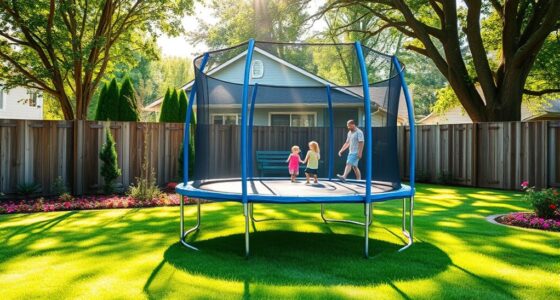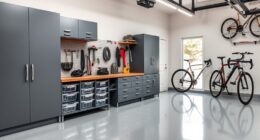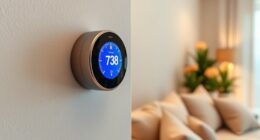If you work out regularly, setting up a home gym can save you money over time compared to paying for a gym membership. While a home gym requires an upfront cost of $175–$250, it avoids monthly fees and travel expenses. Gym memberships, especially premium ones, can add up quickly and include hidden costs like classes or trainers. To discover how to maximize savings and make the best choice for your fitness goals, keep exploring.
Key Takeaways
- Home gyms have higher upfront costs but lower long-term expenses compared to ongoing gym membership fees.
- Monthly gym memberships can add up, especially with additional class or trainer fees, reducing overall savings.
- Infrequent workouts make gym memberships less cost-effective, favoring home gyms for sporadic exercise routines.
- Home gyms eliminate travel, waiting, and extra charges, increasing convenience and potential savings over time.
- Well-maintained home equipment offers better long-term value, especially if used regularly, compared to paying for gym access.

Are you trying to decide between setting up a home gym or joining a commercial fitness center? The choice largely depends on your budget, workout habits, and lifestyle. Initially, a basic home gym setup costs between $175 and $250, which is a one-time expense. If you prefer a more elaborate setup with advanced equipment, expect to spend between $2,500 and $5,000 or more. In contrast, a typical gym membership costs around $10 to $25 per month, totaling roughly $120 to $300 annually. Premium memberships, offering amenities like pools and personal trainers, range from $100 to $200 monthly, adding up to $1,200 to $2,400 yearly. Over five years, a basic home gym can save you between $425 and $1,200 compared to basic gym memberships, and an elaborate home gym could save between $3,500 and $7,000 versus premium gyms.
However, consider the hidden and recurring costs of commercial gyms. Monthly fees average about $52 to $58, with higher prices in major cities. Some gyms charge additional fees for classes, personal training, or equipment rentals, which can range from $34 to $120 per session. Plus, you’ll need to account for travel costs,—fuel, parking, transit fares—that add to the overall expense. Commuting also takes time, which can be viewed as an opportunity cost, reducing the convenience of gym memberships. This time spent traveling and waiting for equipment can diminish the overall value of your membership, especially if your workouts are irregular. [Furthermore, some gyms have membership cancellation policies that include long-term contracts or fees, making it difficult to switch or stop without penalty.]
Hidden costs like travel time and extra fees can make gym memberships less economical than they seem.
When it comes to convenience and accessibility, home gyms offer unmatched flexibility with 24/7 access, eliminating the need for travel or waiting. You can work out whenever it fits your schedule, which might boost consistency. Plus, you don’t need to worry about hygiene or crowded peak hours. On the other hand, commercial gyms provide a variety of amenities—like pools, fitness classes, and professional trainers—that a home gym might lack or require additional investment to replicate. They also offer specialized equipment and expert guidance, which can enhance your workout experience but at a higher ongoing cost. The diversity of equipment and classes available at gyms can also motivate users to try new routines and stay engaged with their fitness journey. Additionally, the presence of a social environment can encourage accountability and motivation for some users.
Equipment quality varies widely at home. Basic setups cost less but may lack durability, while high-end systems can match or exceed gym-quality equipment, representing a long-term investment. Well-maintained home gym equipment can also retain resale value, unlike memberships that only grant access. Additionally, the more you work out at home, the more cost-effective it becomes since there are no per-use fees. Irregular gym attendance reduces the value of a membership, making a home gym a smarter financial choice if your workouts are sporadic. Ultimately, your decision hinges on your fitness goals, budget, and how often you plan to work out.
Frequently Asked Questions
How Long Does It Take to See Results With a Home Gym?
You’ll notice initial results in 2 to 8 weeks, thanks to neural adaptations and forming a workout habit. Early progress includes increased strength, endurance, and muscle tone, especially if you’re consistent. By three months, you’ll see visible changes like improved muscle definition and cardiovascular health. Keep in mind, steady effort and proper form are key, with ongoing improvements possible over six months or more as you refine your routine.
Are There Hidden Costs in Maintaining a Home Gym?
You might think maintaining a home gym is cheap, but hidden costs can surprise you. Regular equipment maintenance, replacement parts, and tech subscriptions add up over time. Utilities like electricity and heating increase monthly bills, and possible property damage or upgrades can be costly. These ongoing expenses often go unnoticed initially, making it essential to budget beyond just the purchase price to truly understand the true cost of maintaining your home gym.
Which Option Offers Better Access to Diverse Equipment?
You want access to diverse equipment, but your options depend on your setup. Commercial gyms offer a wider range of specialized machines, cardio tech, and heavy-duty gear, perfect for varied workouts. Home gyms typically focus on basic, multi-use equipment that fits limited space and budget. If variety’s a priority, a commercial gym gives you more options. But, if you’re budget-conscious, a well-equipped home gym still covers essential exercises.
How Does Gym Atmosphere Impact Motivation and Consistency?
Gym atmosphere plays a big role in your motivation and consistency. If you thrive in a social environment, gyms with community, group classes, and peer support boost your engagement. Feeling comfortable, motivated, and challenged helps you stick to your routine. Whether it’s the accountability from others or the enjoyment of shared goals, a positive atmosphere keeps you inspired, making it easier to stay consistent and reach your fitness goals.
Can a Home Gym Replace All Features of a Commercial Gym?
In the grand scheme of fitness, you might think a home gym can replace all features of a commercial gym. However, it’s like trying to fit a Cadillac into a compact car—limited by space and equipment variety. While you can cover basic workouts, you won’t match the diverse machines, heavy-duty durability, or advanced tech of a commercial gym. For inclusive training, a commercial setup still holds the upper hand.
Conclusion
So, which option truly saves you more money—building your home gym or sticking with a commercial membership? Think about your long-term goals, daily routines, and how much you value convenience. Remember, investing in your health shouldn’t break the bank, but it should inspire you to stay committed. Are you ready to make a choice that balances your budget with your fitness dreams? Ultimately, the best decision is the one that keeps you moving and motivated.









